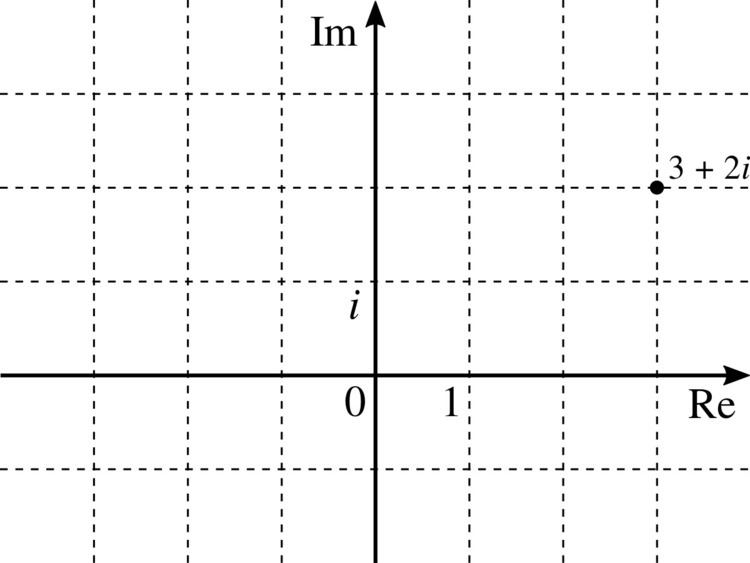 | ||
In number theory, a Gaussian integer is a complex number whose real and imaginary parts are both integers. The Gaussian integers, with ordinary addition and multiplication of complex numbers, form an integral domain, usually written as Z[i]. This integral domain is a particular case of a commutative ring of quadratic integers. It does not have a total ordering that respects arithmetic.
Contents
Formal definition
Formally, the Gaussian integers are the set
Note that when they are considered within the complex plane the Gaussian integers may be seen to constitute the 2-dimensional integer lattice.
Norm of a Gaussian integer
The (arithmetic or field) norm of a Gaussian integer is the square of its absolute value (Euclidean norm) as a complex number. It is the natural number defined as
where ⋅ (an overline) is complex conjugation.
The norm is multiplicative, since the absolute value of complex numbers is multiplicative, i.e., one has
The latter can also be verified by a straightforward check. The units of Z[i] are precisely those elements with norm 1, i.e. the set {±1, ±i}.
As a principal ideal domain
The Gaussian integers form a principal ideal domain with units {±1, ±i}. For x ∈ Z[i], the four numbers ±x, ±ix are called the associates of x. As for every principal ideal domain, Z[i] is also a unique factorization domain. It follows that a Gaussian integer is prime if and only if it is irreducible.
The prime elements of Z[i] are also known as Gaussian primes. An associate of a Gaussian prime is also a Gaussian prime. The Gaussian primes are symmetric about the real and imaginary axes. The positive integer Gaussian primes are the prime numbers that are congruent to 3 modulo 4, (sequence A002145 in the OEIS). One should not refer to only these numbers as "the Gaussian primes", which refers to all the Gaussian primes, many of which do not lie in Z.
A Gaussian integer a + bi is a Gaussian prime if and only if either:
In other words, a Gaussian integer is a Gaussian prime if and only if either its norm is a prime number, or it is the product by a unit (±1, ±i) of a prime number of the form 4n + 3.
It follows that there are three cases for the factorization of a prime number p in the Gaussian integers:
As an integral closure
The ring of Gaussian integers is the integral closure of Z in the field of Gaussian rationals Q(i) consisting of the complex numbers whose real and imaginary part are both rational.
As a Euclidean domain
It is easy to see graphically that every complex number is no farther than a distance of
Put another way, every complex number (and hence every Gaussian integer) has a maximal distance of
units to some multiple of z, where z is any Gaussian integer; this turns Z[i] into a Euclidean domain, where
Historical background
The ring of Gaussian integers was introduced by Carl Friedrich Gauss in his second monograph on quartic reciprocity (1832) (see [2]). The theorem of quadratic reciprocity (which he had first succeeded in proving in 1796) relates the solvability of the congruence x2 ≡ q (mod p) to that of x2 ≡ p (mod q). Similarly, cubic reciprocity relates the solvability of x3 ≡ q (mod p) to that of x3 ≡ p (mod q), and biquadratic (or quartic) reciprocity is a relation between x4 ≡ q (mod p) and x4 ≡ p (mod q). Gauss discovered that the law of biquadratic reciprocity and its supplements were more easily stated and proved as statements about "whole complex numbers" (i.e. the Gaussian integers) than they are as statements about ordinary whole numbers (i.e. the integers).
In a footnote he notes that the Eisenstein integers are the natural domain for stating and proving results on cubic reciprocity and indicates that similar extensions of the integers are the appropriate domains for studying higher reciprocity laws.
This paper not only introduced the Gaussian integers and proved they are a unique factorization domain, it also introduced the terms norm, unit, primary, and associate, which are now standard in algebraic number theory.
Unsolved problems
Most of the unsolved problems are related to distribution of Gaussian primes in the plane.
There are also conjectures and unsolved problems about the Gaussian primes. Two of them are:
